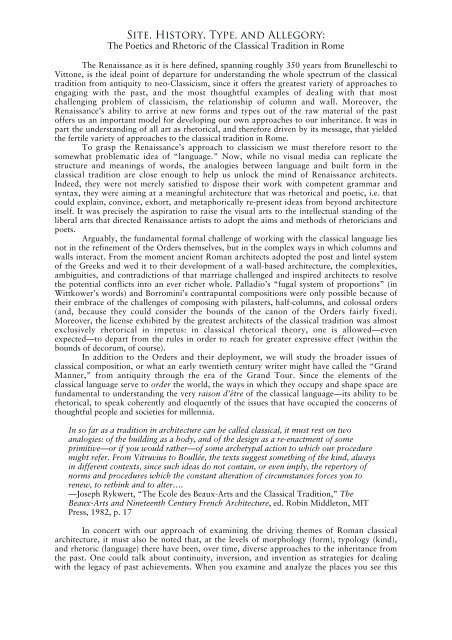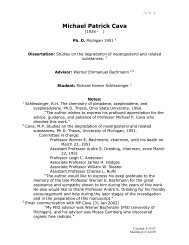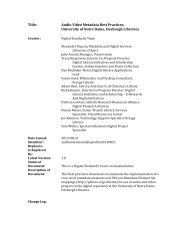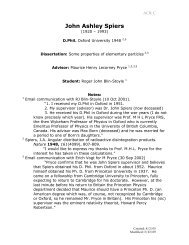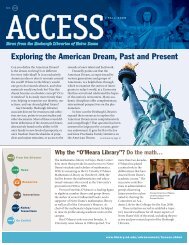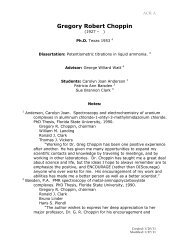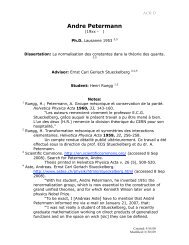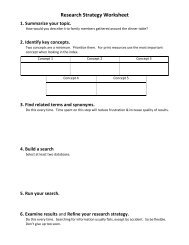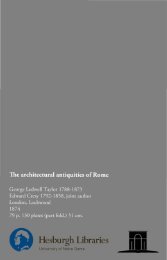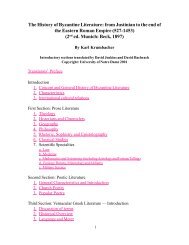ARCH 84312
ARCH 84312
ARCH 84312
You also want an ePaper? Increase the reach of your titles
YUMPU automatically turns print PDFs into web optimized ePapers that Google loves.
Site, History, Type, and Allegory:<br />
The Poetics and Rhetoric of the Classical Tradition in Rome<br />
The Renaissance as it is here defined, spanning roughly 350 years from Brunelleschi to<br />
Vittone, is the ideal point of departure for understanding the whole spectrum of the classical<br />
tradition from antiquity to neo-Classicism, since it offers the greatest variety of approaches to<br />
engaging with the past, and the most thoughtful examples of dealing with that most<br />
challenging problem of classicism, the relationship of column and wall. Moreover, the<br />
Renaissance’s ability to arrive at new forms and types out of the raw material of the past<br />
offers us an important model for developing our own approaches to our inheritance. It was in<br />
part the understanding of all art as rhetorical, and therefore driven by its message, that yielded<br />
the fertile variety of approaches to the classical tradition in Rome.<br />
To grasp the Renaissance’s approach to classicism we must therefore resort to the<br />
somewhat problematic idea of “language.” Now, while no visual media can replicate the<br />
structure and meanings of words, the analogies between language and built form in the<br />
classical tradition are close enough to help us unlock the mind of Renaissance architects.<br />
Indeed, they were not merely satisfied to dispose their work with competent grammar and<br />
syntax, they were aiming at a meaningful architecture that was rhetorical and poetic, i.e. that<br />
could explain, convince, exhort, and metaphorically re-present ideas from beyond architecture<br />
itself. It was precisely the aspiration to raise the visual arts to the intellectual standing of the<br />
liberal arts that directed Renaissance artists to adopt the aims and methods of rhetoricians and<br />
poets.<br />
Arguably, the fundamental formal challenge of working with the classical language lies<br />
not in the refinement of the Orders themselves, but in the complex ways in which columns and<br />
walls interact. From the moment ancient Roman architects adopted the post and lintel system<br />
of the Greeks and wed it to their development of a wall-based architecture, the complexities,<br />
ambiguities, and contradictions of that marriage challenged and inspired architects to resolve<br />
the potential conflicts into an ever richer whole. Palladio’s “fugal system of proportions” (in<br />
Wittkower’s words) and Borromini’s contrapuntal compositions were only possible because of<br />
their embrace of the challenges of composing with pilasters, half-columns, and colossal orders<br />
(and, because they could consider the bounds of the canon of the Orders fairly fixed).<br />
Moreover, the license exhibited by the greatest architects of the classical tradition was almost<br />
exclusively rhetorical in impetus: in classical rhetorical theory, one is allowed—even<br />
expected—to depart from the rules in order to reach for greater expressive effect (within the<br />
bounds of decorum, of course).<br />
In addition to the Orders and their deployment, we will study the broader issues of<br />
classical composition, or what an early twentieth century writer might have called the “Grand<br />
Manner,” from antiquity through the era of the Grand Tour. Since the elements of the<br />
classical language serve to order the world, the ways in which they occupy and shape space are<br />
fundamental to understanding the very raison d’être of the classical language—its ability to be<br />
rhetorical, to speak coherently and eloquently of the issues that have occupied the concerns of<br />
thoughtful people and societies for millennia.<br />
In so far as a tradition in architecture can be called classical, it must rest on two<br />
analogies: of the building as a body, and of the design as a re-enactment of some<br />
primitive—or if you would rather—of some archetypal action to which our procedure<br />
might refer. From Vitruvius to Boullée, the texts suggest something of the kind, always<br />
in different contexts, since such ideas do not contain, or even imply, the repertory of<br />
norms and procedures which the constant alteration of circumstances forces you to<br />
renew, to rethink and to alter….<br />
—Joseph Rykwert, “The Ecole des Beaux-Arts and the Classical Tradition,” The<br />
Beaux-Arts and Nineteenth Century French Architecture, ed. Robin Middleton, MIT<br />
Press, 1982, p. 17<br />
In concert with our approach of examining the driving themes of Roman classical<br />
architecture, it must also be noted that, at the levels of morphology (form), typology (kind),<br />
and rhetoric (language) there have been, over time, diverse approaches to the inheritance from<br />
the past. One could talk about continuity, inversion, and invention as strategies for dealing<br />
with the legacy of past achievements. When you examine and analyze the places you see this


